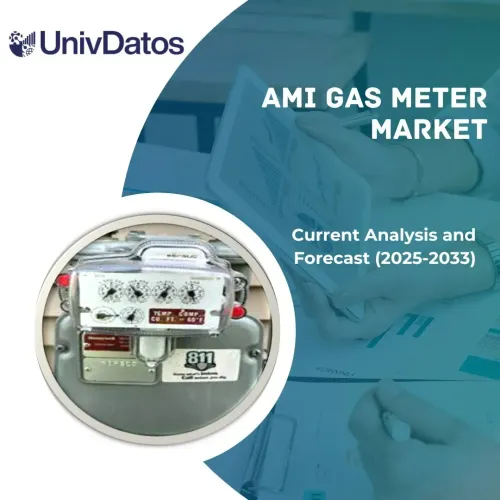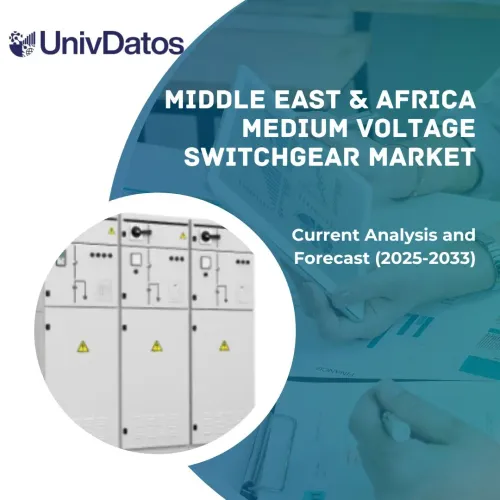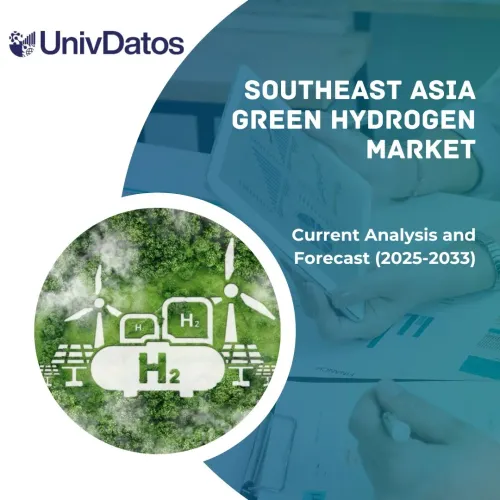- Home
- About Us
- Industry
- Services
- Reading
- Contact Us
Photovoltaic Market: Current Analysis and Forecast (2025-2033)
Emphasis on Type (Module, Inverter, Balance of System (BOS)); Material (Silicon Compound); Cell Type (Full Cell PV Modules, Half-Cell PV Modules); Installation Type (Residential, Commercial & Industrial, Utilities); Region/Country
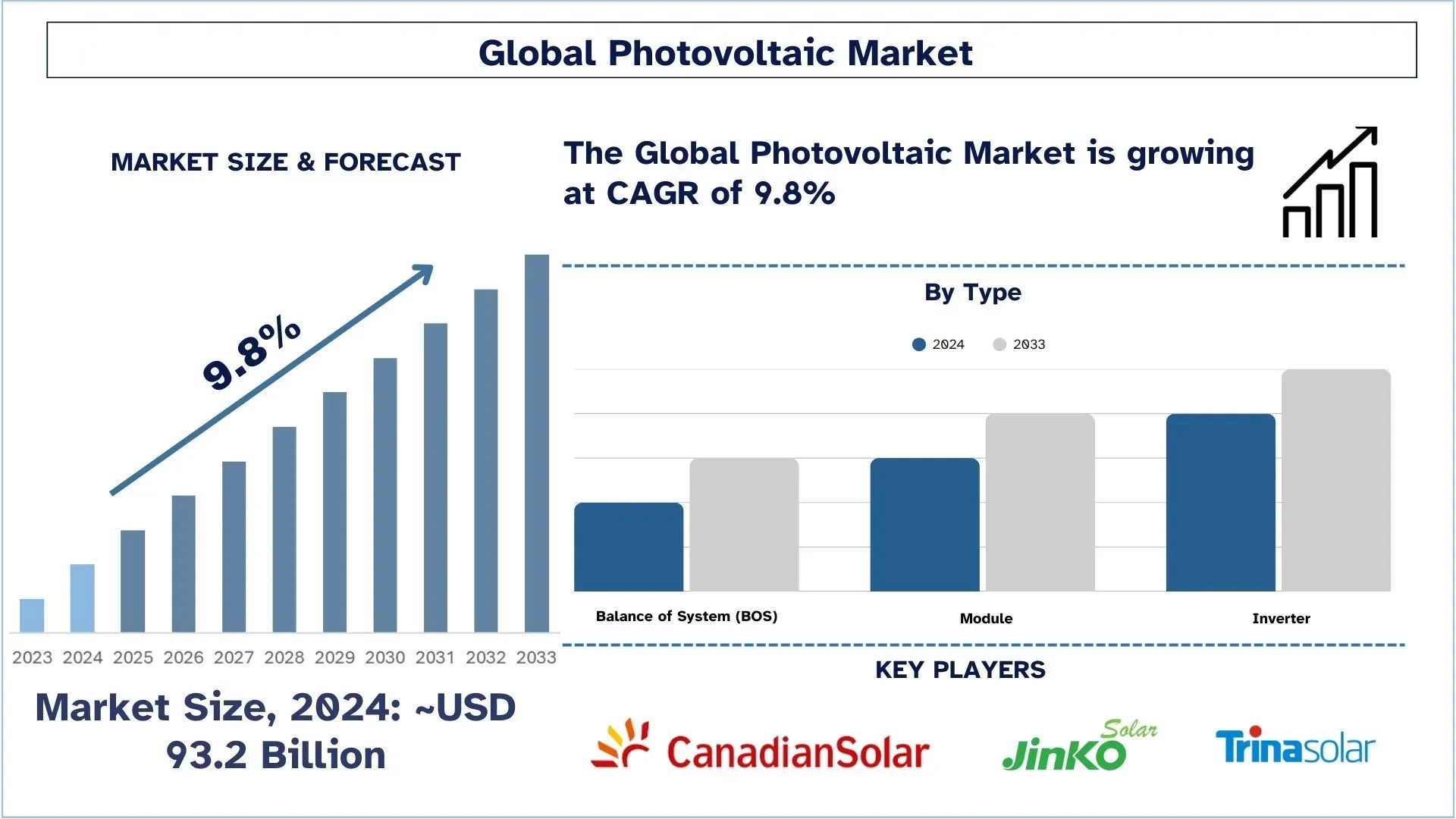
Photovoltaic Market Size & Forecast
The Photovoltaic Market was valued at approximately USD 93.2 billion in 2024 and is expected to grow at a substantial CAGR of around 9.8% during the forecast period (2025-2033), owing to the growing demand for clean, renewable energy.
Photovoltaic Market Analysis
Photovoltaic energy is produced by the radiation of the sun, and it can be converted into electricity with the help of photovoltaic cells. This electricity can be used to power electric devices. Depending on the application, the photovoltaic cells can be used as a solar lamp, parking meters, emergency telephones, trash compactors, temporary traffic signs, and charging stations in commercial applications. Similarly, in the agriculture sector, photovoltaic technology is used to generate electricity to run water pumps at a cheaper cost, and with surging use of photovoltaic technology, it’s expected to accelerate its market share in the forecasted period as well. Moreover, the surging demand for electricity across the globe, owing to the rising population, coupled with the rising need to adopt sustainable renewable energy sources, is a factor fueling the market size of the global photovoltaic market. In addition, government favorable policies and regulations to reduce carbon footprints and low-cost energy generation are also the key factors that fuel the demand for the photovoltaic market.
Photovoltaic Market Trends
This section discusses the key market trends influencing the various segments of the Photovoltaic market as identified by our research experts.
The rapid shift toward high-efficiency technologies
A major development in the global PV market is already discernible in the form of high-efficiency enhancements such as TOPCon and HJT and perovskite tandem systems. These innovations aim at achieving more power and a reduced levelized cost of electricity and improved solar farm output in the developed and emerging markets. Top players currently put much effort into enhancing the manufacturing processes to include these next-generation modules in their production lines as a competitive advantage in terms of output, cost, and future-proofing the technology.
Photovoltaic Industry Segmentation
This section provides an analysis of the key trends in each segment of the global Photovoltaic report, along with forecasts at the global, regional, and country levels for 2025-2033.
The Inverter Segment Holds the Largest Share of the Market.
Based on type, the global photovoltaic market is segmented into module, inverter, and balance of system (BOS). Currently, the inverters segment dominates the market. A solar inverter can convert DC power to AC power, which is then effectively used for residential applications. Moreover, the increasing advancement in solar inverter technology helps in improving its performance level, and with surging adoption of rooftop photovoltaic, solar inverter demand is also rising, which in turn would accelerate the inverter market share in the forecasted period as well.
The Silicon Segment is Expected to Witness a Higher CAGR than the Photovoltaic Market.
Based on material, the market is bifurcated into silicon and compound. The Silicon segment dominates the market. The silicon photovoltaic material is expected to witness rapid growth owing to the benefits of crystalline silicon solar cells that increase efficiency and reduce the cost of final installation of photovoltaic systems, as fewer solar cells need to be installed for the desired output.
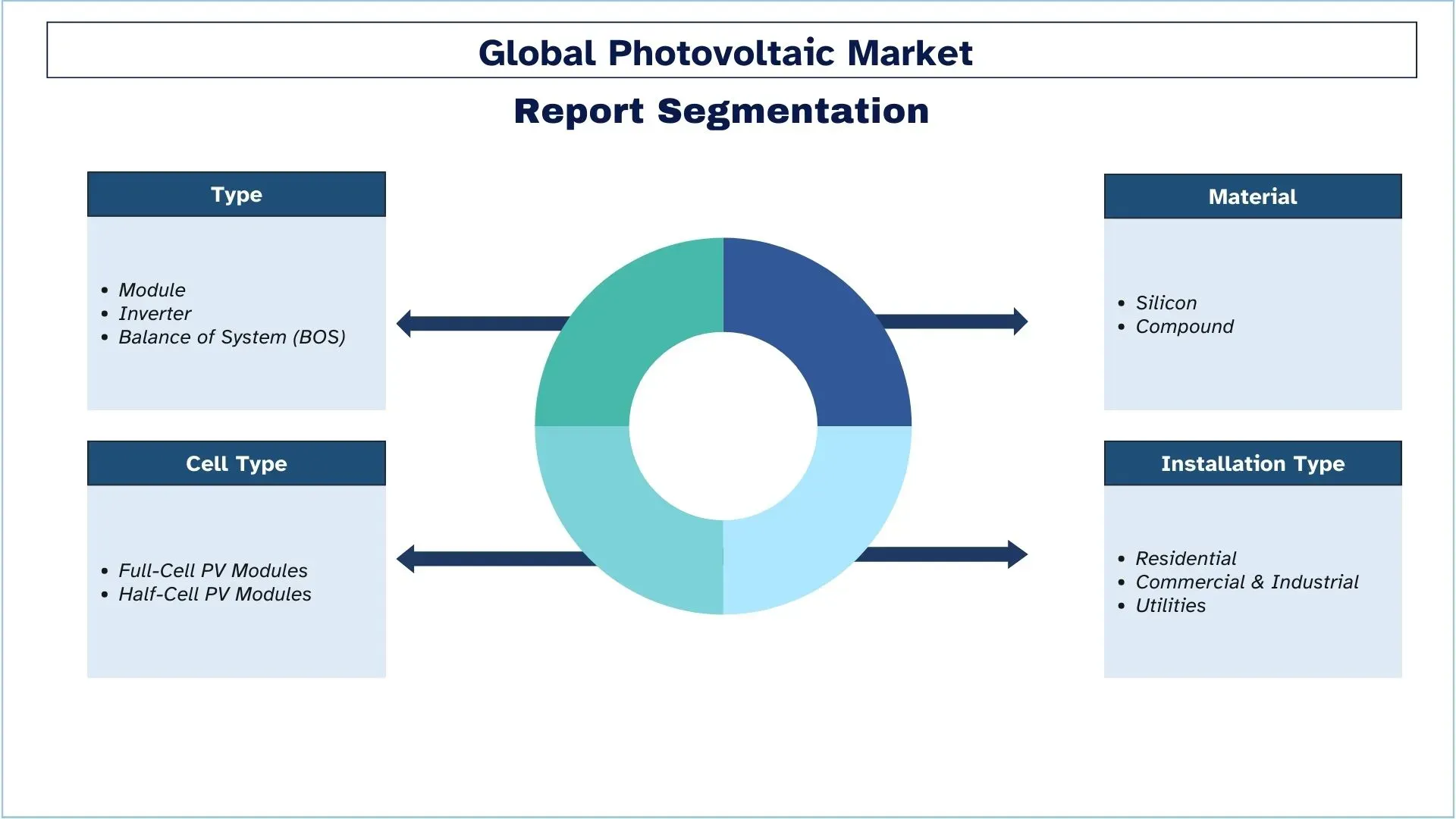
APAC has a significant share of the market in 2024.
APAC countries are major photovoltaic markets because of the energy demands, government support budgets, and intent to have an enhanced percentage of renewable energy in their total power generation, such as China, India, Japan, South Korea, and Australia. This makes solar power more affordable since APAC is the manufacturing hub of most of the solar parts and gets to enjoy economies of scale and technological improvements. The region is observed to be gradually deploying large-scale solar power plants as well as rooftop systems with the help of favorable policies, decreasing cost of modules, and climate initiatives declaring a shift toward renewable power.
China Dominates the APAC Photovoltaic Market
China remains the leading manufacturer that supplies photovoltaic (PV) solar panels to the global market and has the biggest photovoltaic industry in the world. Through receiving steadfast governmental support, sound policies, and superior manufacturing capability, the country takes a leading position in both upstream and downstream markets, including wafer, cell & module, as well as utility-scale projects and distributed PV. China’s goals on energy transformation and carbon neutrality are increasing the country’s investment and exports of domestic solar panels and components, together with the global solar industry.
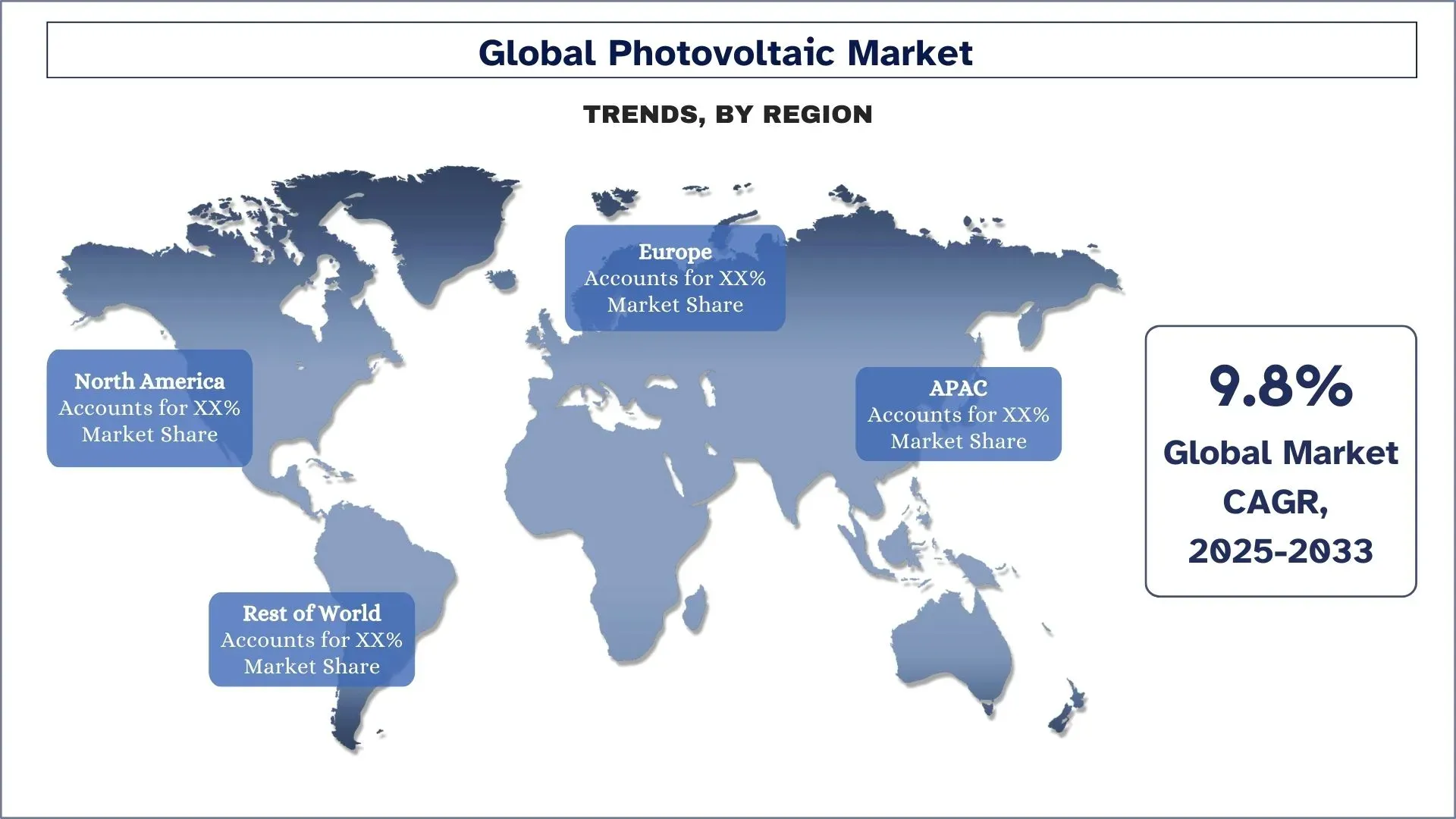
Photovoltaic Industry Competitive Landscape
The Photovoltaic market is competitive, with several global and international players. The key players are adopting different growth strategies to enhance their market presence, such as partnerships, agreements, collaborations, new product launches, geographical expansions, and mergers and acquisitions.
Top Photovoltaic Companies
Some of the major players operating in the market are Canadian Solar, Trina Solar Limited, Jinko Solar Holding, GCL System Integration, JA Solar Holdings, Shunfeng International Clean Energy Limited, Sharp Corporation, Risen Energy, Mitsubishi Electric Corporation, and Suntech Power (Shunfeng Int'l)
Recent Developments in the Photovoltaic Market
In June 2022, JinkoSolar announced that it had executed an agreement to supply approximately one gigawatt of its high-efficiency n-type bifacial Tiger Neo solar panels to China Datang Corporation to power its six utility-scale solar projects located in Hunan and Guangxi provinces.
In March 2022, Canadian Solar announced it had started the mass production of a new 54-cell format module with 182 mm cells for residential, commercial, and industrial rooftop solar systems. CS6R-MS, the new module type under the HiKu6 series, has a power output of up to 420 W and a module efficiency of up to 21.5%. The CS6R-MS module is especially suitable for rooftop solar applications given its small module size, lightweight (21.3 kg), and outstanding aesthetic design for a homogenous appearance.
Photovoltaic Market Report Coverage
Report Attribute | Details |
Base year | 2024 |
Forecast period | 2025-2033 |
Growth momentum | Accelerate at a CAGR of 9.8% |
Market size 2024 | USD 93.2 Billion |
Regional analysis | APAC, Europe, Asia-Pacific, Rest of the World |
Major contributing region | APAC is expected to grow at the highest CAGR during the forecasted period. |
Key countries covered | U.S., Canada, Germany, France, UK, Spain, Italy, China, Japan, and India |
Companies profiled | Canadian Solar, Trina Solar Limited, Jinko Solar Holding, GCL System Integration, JA Solar Holdings, Shunfeng International Clean Energy Limited, Sharp Corporation, Risen Energy, Mitsubishi Electric Corporation, and Suntech Power (Shunfeng Int'l). |
Report Scope | Market Trends, Drivers, and Restraints; Revenue Estimation and Forecast; Segmentation Analysis; Demand and Supply Side Analysis; Competitive Landscape; Company Profiling |
Segments Covered | By Type, By Material, By Cell Type, By Installation Type, By Region/Country |
Reasons to Buy the Photovoltaic Market Report:
The study includes market sizing and forecasting analysis validated by authenticated key industry experts.
The report presents a quick review of overall industry performance at a glance.
The report covers an in-depth analysis of prominent industry peers with a primary focus on key business financials, product portfolios, expansion strategies, and recent developments.
Detailed examination of drivers, restraints, key trends, and opportunities prevailing in the industry.
The study comprehensively covers the market across different segments.
Deep dive regional-level analysis of the industry.
Customization Options:
The global Photovoltaic market can be customized further as per the requirements or any other market segment. Besides this, UnivDatos understands that you may have your own business needs; hence, feel free to contact us to get a report that completely suits your requirements.
Table of Content
Research Methodology for Photovoltaic Market Analysis (2023-2033)
We analyzed the historical market, estimated the current market, and forecasted the future market of the global Photovoltaic market to assess its application in major regions worldwide. We conducted exhaustive secondary research to gather historical market data and estimate the current market size. To validate these insights, we carefully reviewed numerous findings and assumptions. Additionally, we conducted in-depth primary interviews with industry experts across the Photovoltaic value chain. After validating market figures through these interviews, we used top-down and bottom-up approaches to forecast the overall market size. We then employed market breakdown and data triangulation methods to estimate and analyze the market size of industry segments and sub-segments.
Market Engineering
We employed data triangulation techniques to finalize the overall market estimation and derive precise statistical numbers for each segment and sub-segment of the global Photovoltaic market. We split the data into several segments and sub-segments by analyzing various parameters and trends, including type, material, cell type, installation type, and regions within the global Photovoltaic market.
The main objective of the Global Photovoltaic Market Study
The study identifies current and future trends in the global Photovoltaic market, providing strategic insights for investors. It highlights regional market attractiveness, enabling industry participants to tap into untapped markets and gain a first-mover advantage. Other quantitative goals of the studies include:
Market Size Analysis: Assess the current and forecast market size of the global Photovoltaic market and its segments in terms of value (USD).
PHOTOVOLTAIC Market Segmentation: The study segments the market by type, material, cell type, installation type, and region.
Regulatory Framework & Value Chain Analysis: Examine the regulatory framework, value chain, customer behavior, and competitive landscape of the Photovoltaic industry.
Regional Analysis: Conduct a detailed regional analysis for key areas such as Asia Pacific, Europe, North America, and the Rest of the World.
Company Profiles & Growth Strategies: Company profiles of the Photovoltaic market and the growth strategies adopted by the market leaders to sustain the fast-growing market.
Frequently Asked Questions FAQs
Q1: What is the Photovoltaic market's current size and growth potential?
As of 2024, the global photovoltaic market is valued at approximately USD 93.2 billion and is projected to grow at a CAGR of 9.8% through 2033.
Q2: What are the driving factors for the growth of the Photovoltaic market?
The growing demand for clean, renewable energy is driven by climate goals and supportive government policies.
Q3: Which market has the largest share of the Photovoltaic market by type?
The Inverter Segment dominates the global photovoltaic market by type segment.
Q4: What are the major trends in the Photovoltaic market?
Rising adoption of bifacial and high-efficiency solar panels for increased energy yield.
Q5: Which region will dominate the Photovoltaic market?
The APAC region currently dominates the global Photovoltaic market.
Q6: What are the biggest challenges in the Photovoltaic market?
Supply chain bottlenecks and dependency on a few countries for key raw materials like polysilicon.
Q7: Who are the Top players in the global Photovoltaic market?
The leading companies driving innovation in Photovoltaic include:
• Canadian Solar
• Trina Solar Limited
• Jinko Solar Holding
• GCL System Integration
• JA Solar Holdings
• Shunfeng International Clean Energy Limited
• Sharp Corporation
• Risen Energy
• Mitsubishi Electric Corporation
• Suntech Power (Shunfeng Int'l)
Q8: What are the key areas of investment opportunity in the global photovoltaic market?
Key investment areas include high-efficiency solar cell technologies (such as TOPCon, HJT, and perovskite tandem), energy storage integration with PV systems, and smart grid infrastructure. Investors are also exploring opportunities in utility-scale solar farms in emerging markets and vertical integration across the solar supply chain to reduce dependency on raw material imports.
Q9: How can solar companies stay competitive amid global price fluctuations and supply chain disruptions?
To stay competitive, companies should focus on diversifying their supplier base, investing in advanced manufacturing automation, and adopting sustainable sourcing practices. Strengthening R&D capabilities and forming strategic partnerships can also help improve product efficiency, reduce costs, and ensure resilience against geopolitical or trade-related disruptions.
Related Reports
Customers who bought this item also bought

